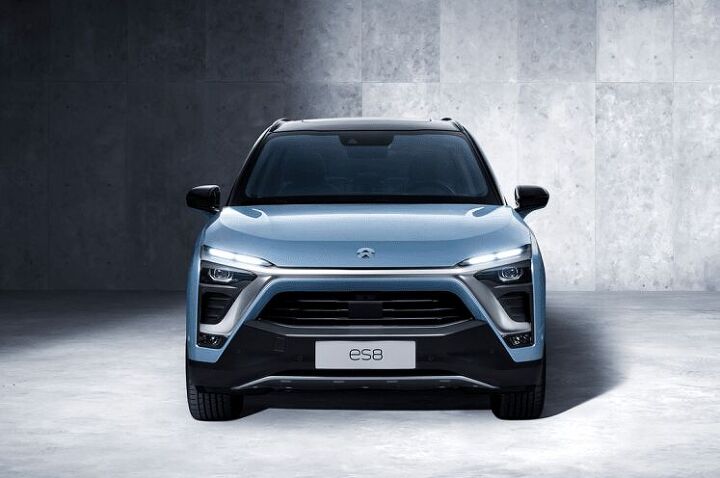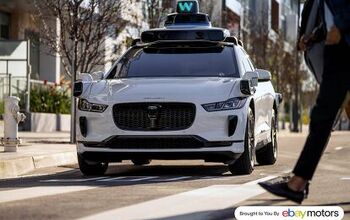China's NIO Sold 3,268 Autos Last Quarter, Most of Them Last Month

Nio, originally launched as NextEV in 2014, announced that it had delivered 3,268 electric SUVs in the third quarter of 2018. Not only does this beg the question of when Nio swapped from Formula E and electrified hypercars to utility vehicles, but it also makes us wonder how a burgeoning EV firm managed to surpass production goals. Aren’t all zero-emission automobiles that aren’t developed by established automakers supposed to languish in purgatory?
Answering the first question is easy. Nio started deliveries of the ES8 crossover last June, though it still sells the high-performance EP9 for $1.2 million. We doubt that model provided any significant contributions to overall volume in Q3. The trickier bit of this equation is figuring out how the Nio moved all that metal. While 3,200 cars is a paltry some for a mainstream manufacturer, it’s pretty damn good for a company that just started building a volume electric. Even Tesla would have been envious in 2012.
Like a lot of Chinese automotive startups, Nio has been getting cash from the government. However, according to Reuters, the brunt of its initial funding came from the Asian tech-giant Tencent Holdings — which invests in just about anything focused on the future. It also raised $1 billion during its initial public offering last month. Included in the investor’s list was Baillie Gifford, who acquired an 11.4-percent stake in the company. Apparently, having a big-time Tesla investor made the market react accordingly. Share prices shot up 22 percent earlier this month, yielding Gifford an instantaneous profit.
Nio’s influx of fresh capital will go toward readying the smaller ES6 (due in the summer of 2019) and ensuring it can make good on the nearly 16,000 reservations for the ES8. Despite a relatively modest production capabilities and planned idling for Chinese holidays, Nio still claims it can manage 10,000 ES8 deliveries by year’s end.
Nio’s early success isn’t simply a matter of attracting the right backers. It’s also building the kind of car that gets well-paid tech heads tugging at their pants … so they can whip out their wallets. The ES8 is said to play host to a manufacturer-claimed 643 horsepower and 619 pound-feet of torque. That puts it in position to reach 60 mph in roughly 4.5 seconds. It is also said to be capable of over 200 miles when its 70 kWh battery is fully charged, and measures about 198 inches in length. That’s just about the perfect size, shape, and speed for the current market’s taste for premium EVs.
At $86,880 (in yuan) for the fully loaded Founder’s Edition, that’s also the right price. However, Nio has said it’s working on a less-expensive variant that should come in around $68,000. Both models are said to be equipped with its adorable AI system that lives in a bubble on top of the dashboard, affectionately known as Nomi.
The company is currently attempting to figure out how to best translate Nomi for the American market, as it would like to begin selling vehicles here in 2020. With a U.S.-China trade war currently at full pitch, that might not be a realistic goal. Also, Nio planning on selling its vehicles directly to customers via the internet. Still, it’s a company to watch, as it appears to have crested the first hill that most EV firms typically die on.
[Image: Nio]

A staunch consumer advocate tracking industry trends and regulation. Before joining TTAC, Matt spent a decade working for marketing and research firms based in NYC. Clients included several of the world’s largest automakers, global tire brands, and aftermarket part suppliers. Dissatisfied with the corporate world and resentful of having to wear suits everyday, he pivoted to writing about cars. Since then, that man has become an ardent supporter of the right-to-repair movement, been interviewed on the auto industry by national radio broadcasts, driven more rental cars than anyone ever should, participated in amateur rallying events, and received the requisite minimum training as sanctioned by the SCCA. Handy with a wrench, Matt grew up surrounded by Detroit auto workers and managed to get a pizza delivery job before he was legally eligible. He later found himself driving box trucks through Manhattan, guaranteeing future sympathy for actual truckers. He continues to conduct research pertaining to the automotive sector as an independent contractor and has since moved back to his native Michigan, closer to where the cars are born. A contrarian, Matt claims to prefer understeer — stating that front and all-wheel drive vehicles cater best to his driving style.
More by Matt Posky
Latest Car Reviews
Read moreLatest Product Reviews
Read moreRecent Comments
- Zipper69 "At least Lincoln finally learned to do a better job of not appearing to have raided the Ford parts bin"But they differentiate by being bland and unadventurous and lacking a clear brand image.
- Zipper69 "The worry is that vehicles could collect and share Americans' data with the Chinese government"Presumably, via your cellphone connection? Does the average Joe in the gig economy really have "data" that will change the balance of power?
- Zipper69 Honda seem to have a comprehensive range of sedans that sell well.
- Oberkanone How long do I have to stay in this job before I get a golden parachute?I'd lower the price of the V-Series models. Improve the quality of interiors across the entire line. I'd add a sedan larger then CT5. I'd require a financial review of Celestiq. If it's not a profit center it's gone. Styling updates in the vision of the XLR to existing models. 2+2 sports coupe woutd be added. Performance in the class of AMG GT and Porsche 911 at a price just under $100k. EV models would NOT be subsidized by ICE revenue.
- NJRide Let Cadillac be Cadillac, but in the context of 2024. As a new XT5 owner (the Emerald Green got me to buy an old design) I would have happy preferred a Lyriq hybrid. Some who really like the Lyriq's package but don't want an EV will buy another model. Most will go elsewhere. I love the V6 and good but easy to use infotainment. But I know my next car will probably be more electrified w more tech.I don't think anyone is confusing my car for a Blazer but i agree the XT6 is too derivative. Frankly the Enclave looks more prestigious. The Escalade still has got it, though I would love to see the ESV make a comeback. I still think GM missed the boat by not making a Colorado based mini-Blazer and Escalade. I don't get the 2 sedans. I feel a slightly larger and more distinctly Cadillac sedan would sell better. They also need to advertise beyond the Lyriq. I don't feel other luxury players are exactly hitting it out of the park right now so a strengthened Cadillac could regain share.


































Comments
Join the conversation
What a beautyn't. That face resembles the Hyundai Kona featured here today.
I wish I had a dollar for every article I've read over the past decade predicting the imminent release of some Chinese auto into the U.S. market. Might get me a share of AMZN.